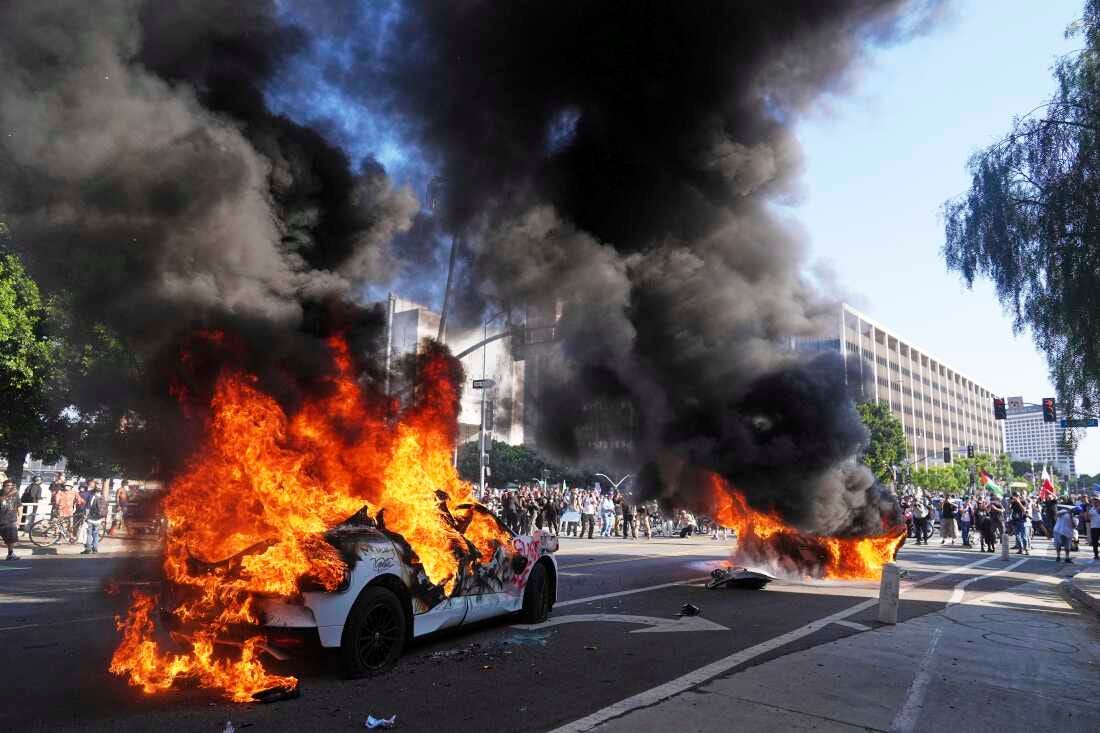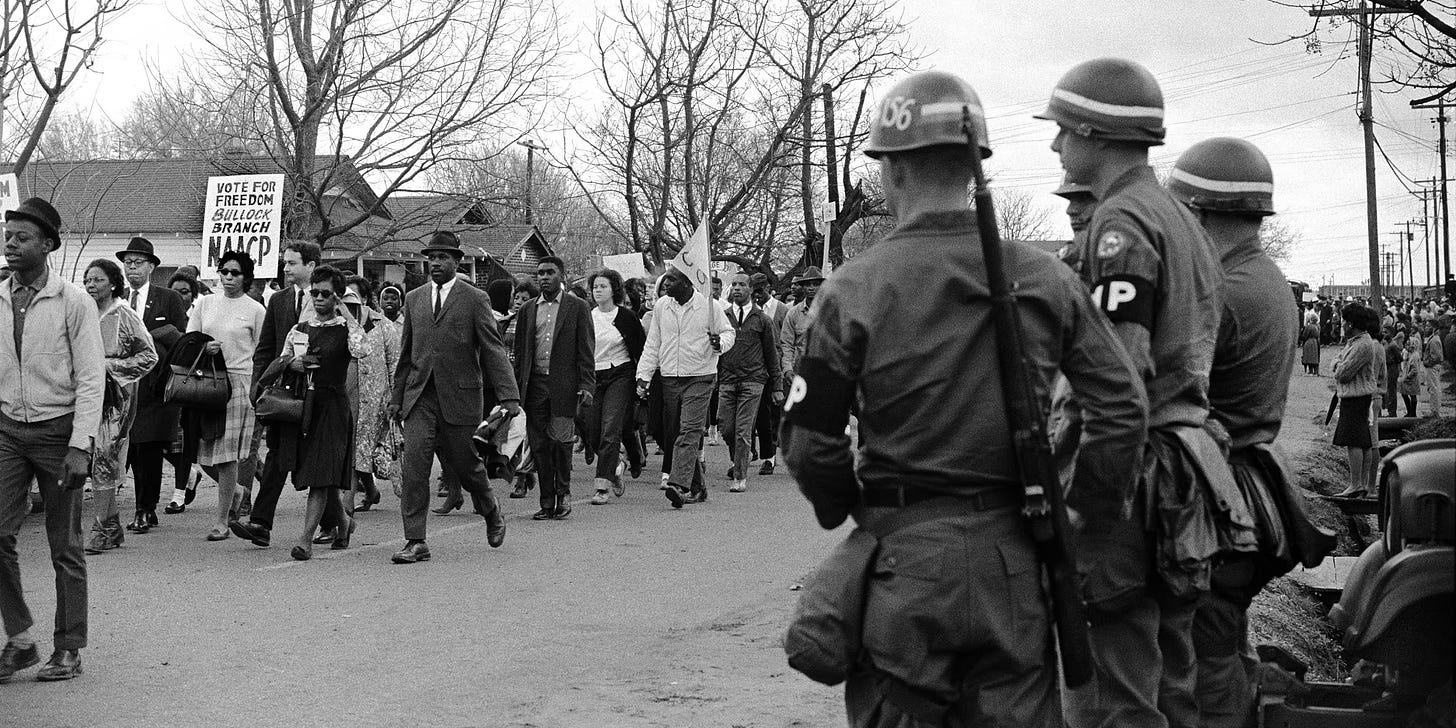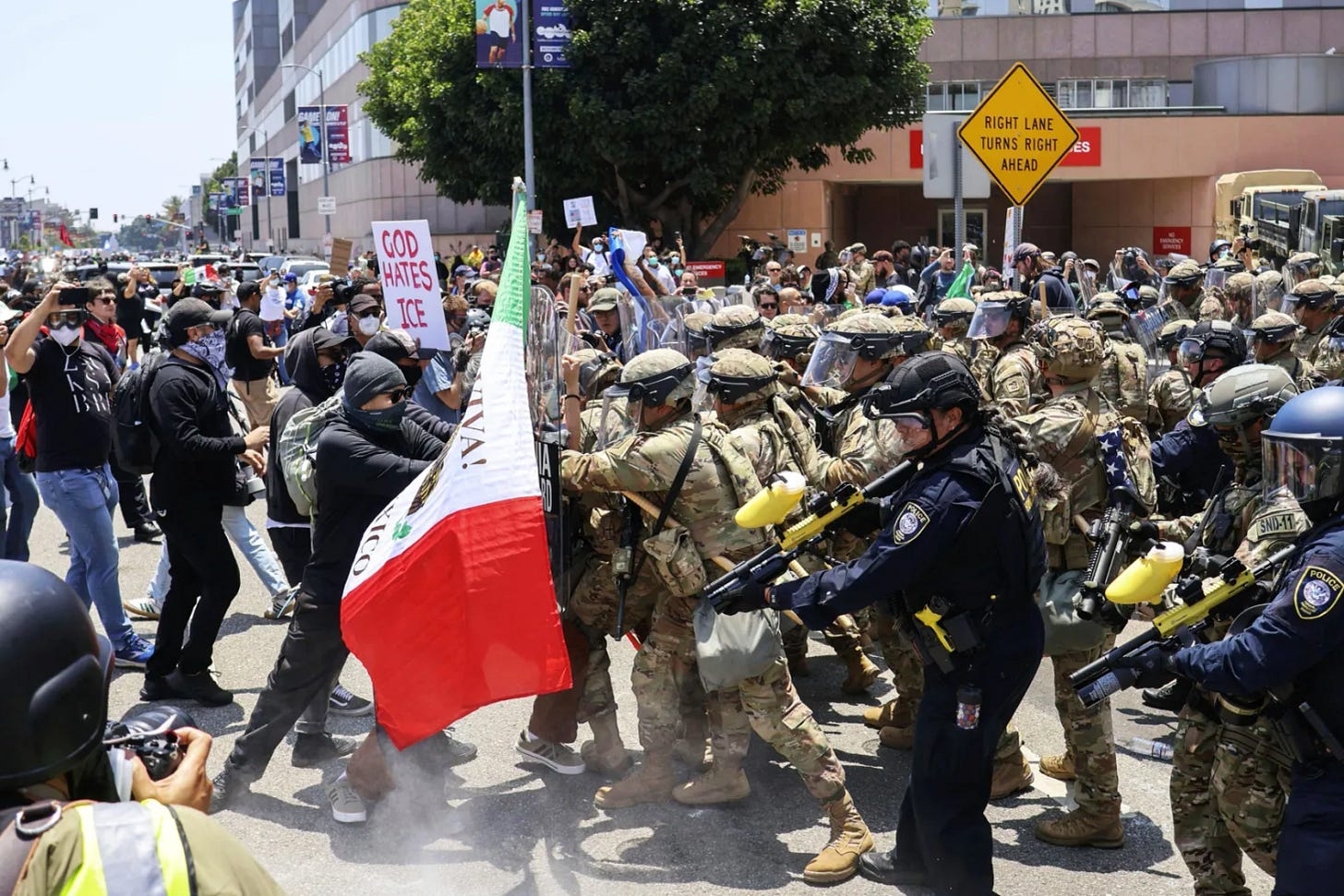Trump's Los Angeles Gambit
Testing the limits of military power at home
Today's issue is sponsored by the Pew-Knight Initiative
When President Donald Trump ordered 2,000 National Guard troops and 700 Marines to Los Angeles this week, he wasn't just responding to violent protests over immigration raids. He was threatening the use of military force against American citizens in alarming and rarely tested ways. And it could just be the beginning.
The troop deployment follows a pattern in Trump's presidency: declaring emergencies or crises where others see manageable situations and then using those declarations to justify sweeping unilateral actions. Trump has already declared eight separate emergencies since taking office — far more than other recent presidents.
They include an economic emergency declared to justify global tariffs even though US trade deficits have been around for decades; an energy emergency declared to justify new oil and gas leasing and the rollback of environmental regulations, despite healthy domestic supplies; and a fentanyl emergency at the Canadian border declared to justify tariffs on our northern neighbor, despite minimal drug flow from that direction. These declarations granted him extraordinary powers to bypass normal government processes and congressional oversight.
The immediate trigger in Los Angeles was clear enough: after Immigration and Customs Enforcement agents swept through places like Home Depot parking lots and clothing manufacturers, arresting day laborers and factory workers, protesters took to the streets.
What began as peaceful demonstrations quickly turned violent, with windows shattered, self-driving cars set ablaze, and officers pelted with rocks and electric scooters. Police responded with flash-bangs and rubber bullets, and Los Angeles declared an "unlawful assembly."
The central question isn't whether violent protesters deserve consequences — they do. By any measure, violence against federal agents is inexcusable, and law enforcement has every right to protect personnel and property.
But the broader context of the military deployment suggests something more calculated than crisis response. The president could be provoking a crisis through harsh immigration raids and then using the predictable protests as justification to deploy the military against the wishes of local authorities. And, he’s already suggesting he plans to continue this practice.
Stoking the fire
The Los Angeles immigration raids were a dramatic departure from traditional enforcement measures, amid Trump's frustration that deportation numbers have fallen short of his promises. ICE ramped up its enforcement actions after White House Deputy Chief of Staff Stephen Miller demanded last month that it make 3,000 arrests a day, compared with a few hundred during Trump's first 100 days. For much of that period, deportations were on par with, and at times below, those recorded during the last year of Joe Biden's presidency.
Rather than targeting violent criminals, as the administration has suggested it is focusing on, ICE agents swept up anyone they could. Six migrants who witnessed the Home Depot raid told The Washington Post that "federal immigration authorities began handcuffing anyone they could grab" in seemingly arbitrary detentions. The agents dressed like commandos and wore skull and skeleton gear.Even some Trump supporters expressed concern. The co-founder of Latinas for Trump, Florida State Senator Ileana Garcia, wrote on X that "this is not what we voted for," criticizing "arbitrary measures to hunt down people who are complying with their immigration hearings… all driven by a Miller-like desire to satisfy a self-fabricated deportation goal."
Trump's decision to deploy military forces did not come at the request of local authorities struggling to maintain order, but over their explicit objections. California Governor Gavin Newsom, who was not consulted, said Trump had ordered “soldiers to engage in unlawful civilian law enforcement activities in communities across the region, beyond just guarding federal buildings,” and filed a lawsuit to immediately block the troop deployment. (A federal judge denied the request and scheduled a hearing for Thursday.)
California employs more than 75,000 uniformed law enforcement personnel, and Los Angeles alone has nearly 9,000 police officers. Los Angeles Police Chief Jim McDonnell, who worked his way up through the LAPD ranks over 29 years and previously led the largest sheriff's department in the United States, said his department remained "confident in our ability" to handle the demonstrations.
But Trump's own comments suggested he was indifferent to local capacity and would judge by his own standard. "Looking really bad in L.A.," he posted on Truth Social. "BRING IN THE TROOPS!!!" When asked about the threshold for deploying Marines, Trump replied: "The bar is what I think it is."
From Pew Research Center:
A new Pew Research Center analysis from the Pew-Knight Initiative explores: What is “news” to Americans – and what isn’t?
Several journalists and editors we interviewed felt that in the digital age, the power to define news has largely shifted from media gatekeepers to the general public. In an online discussion board, participants acknowledged that their personal identities influence how they consume or think about news.
And our survey of U.S. adults shows that people’s definition of news includes whether something is factual or important to society.
Explore the full report here!
Constitutional crisis in the making
The Posse Comitatus Act of 1878 generally prohibits domestic military deployment, but Trump justified his action by invoking a rarely used provision of another law from the 1800s — the Enforcement Act — that allows federal control of National Guard troops during “rebellion or danger of rebellion."
The deployment marks only the second time in nearly 60 years that a president has called up National Guard troops over a governor's objections. The last instance was in 1965, when President Lyndon Johnson sent troops to protect civil rights marchers in Alabama — using federal power to defend the Constitution against segregationist state resistance.
Trump's action, on the other hand, uses federal force to override state sovereignty for the sake of his administration’s immigration agenda.
More ominously, White House officials, including Miller and Vice President JD Vance, have repeatedly used the term "insurrection" to describe the protests. They appear to be laying the groundwork for the Trump administration to invoke the Insurrection Act, which would allow active-duty military forces to conduct law enforcement operations on American soil. Trump himself has called protesters "insurrectionists," though when pressed, he acknowledged, "I wouldn't call it quite an insurrection, but it could have led to an insurrection."
A dangerous precedent
The military deployment reveals fundamental problems with using federal troops for domestic law enforcement — and raises deeper concerns about the politicization of the armed forces. As retired Army Lieutenant General Russel Honoré, who led the Army's efforts after Hurricane Katrina, explained, "Marine infantry units focus on lethal force as opposed to less-than-lethal force, so they are typically not trained or equipped to deal with civil disturbances." As a result, they can lack the "police mindset" of de-escalation and minimum force.
History underscores these dangers. During the 1992 Los Angeles riots, California requested the federal government’s help. But miscommunication between Marines and police nearly turned tragic when different tactical protocols led to a squad of Marines opening fire on a house during a domestic dispute, leaving over 200 bullet holes but no casualties.
With federal and local officials opposed rather than coordinating this time, we may not be so fortunate. John Miller, formerly a deputy commissioner of intelligence and counterterrorism for the New York Police Department and an assistant director of the FBI, raised a chilling question: without proper coordination and clear rules of engagement between federal and local authorities, "are we two bad judgment calls away from Kent State?" — a reference to the 1970 incident when Ohio National Guard troops fired into a crowd of student protesters, killing four and wounding nine.
A larger strategy?
Trump's memo authorizing the deployment is written in sweeping terms that suggest a nationwide mobilization. It authorizes military troops to protect federal functions anywhere protests are occurring, or — most troublingly — "are likely to occur based on current threat assessments."
This preemptive authorization for military deployment against anticipated protests represents an expansion of presidential power that might presage things to come. Writing for The Atlantic, David Frum (who worked for President George W. Bush) warns that the Los Angeles deployment could serve as a “dress rehearsal” for broader expansion of federal powers. He says that Trump's actions fit a troubling pattern that could unfold ahead of the 2026 midterm elections: "Use federal powers in ways to provoke some kind of made-for-TV disturbance — flames, smoke, loud noises, waving of foreign flags. Invoke the disturbance to declare a state of emergency and deploy federal troops. Seize control of local operations of government — policing in June 2025; voting in November 2026."
That might sound alarmist, but it’s worth remembering that Trump hesitated to deploy military force in his first term during the January 6 riot, when the Capitol was under attack by his own supporters, whose crimes he has pardoned. Now, when protesters oppose his immigration policies, he immediately sends troops. Trump himself repeatedly told supporters during last year's election campaign that if reelected he would use the military against "the enemy within,” a label he has applied to his domestic political opponents.
Seen in that light, Trump's Los Angeles experiment could presage a fundamental test of whether America will remain a nation where military force serves lawful civilian authority or become one where civilian authority manipulates military force for political gain.










I understand this article is meant to be critical of Trump and as always, I appreciate that, but the language about the protest is deeply unfair to the people of Los Angeles, carrying water for Trump with inaccurate framing.
For example, even this first line: "he wasn't just responding to violent protests over immigration raids" suggests that the protests are inherently violent (they are overwhelmingly peaceful) and that Trump's actions are a "response" rather than instigation.
Later, there's this: "What began as peaceful demonstrations quickly turned violent, with windows shattered, self-driving cars set ablaze, and officers pelted with rocks and electric scooters. Police responded with flash-bangs and rubber bullets, and Los Angeles declared an 'unlawful assembly.'" The word "turned" here is doing a lot of heavy lifting, failing to reflect the timeline, scope, and scale of the conflict, as well as the obviously disproportionate force at play.
Let's start with "self-driving cars set ablaze." The first fires were the result of tear gas cannisters thrown by law enforcement against protesters on the first day when they were trying to block ICE agents from taking their neighbors at a Home Depot. The cannisters are very hot, so brush in the road divider caught on fire. The next day, when more people peaceably assembled, police began dispensing tear gas again (a chemical weapon which is banned for use in war by the Geneva Protocols), along with flashbangs, less-lethal projectiles, and aggressive physical force. THAT is when people started setting self-driving cars on fire, and even then the photo included here is pretty much the extent of it. Just because Fox News plays the same images over and over doesn't mean it was widespread. The point isn't that setting cars on fire is okay, the point is that law enforcement was responsible for the escalation in use of force, not the protesters.
Next, "officers pelted with rocks and electric scooters." Again, press embedded on the ground in LA report that law enforcement was deploying their weapons on unarmed civilians who at most were yelling curses at them. In many cases, protesters were throwing BACK projectiles that LEOs had launched at THEM. With regard to the scooters, they were initially and mostly used as barricades to block ICE vehicles, and the episodes of them being thrown were rare. Again, not okay, but these are RARE violent actions that are nearly always in response to law enforcement escalation.
The vast majority of gatherings are peaceful, while there are many instances of LEOs and now military acting aggressively and violently against civilians without provocation. For example, there is the Australian reporter who was intentionally shot with a rubber bullet by a cop. Another woman was just walking, trying to get to her apartment, and the officer blocking the road shot her with a rubber bullet at point-blank range. When other civilians tried to give her first aid, the officer threatened to shoot them too. This one wasn't even an active protest, just a person trying to get home!
Finally, "The central question isn't whether violent protesters deserve consequences — they do. By any measure, violence against federal agents is inexcusable, and law enforcement has every right to protect personnel and property." Based on the examples provided above, let me turn this around for a minute: "The central question isn't whether violent LEOs deserve consequences — they do. By any measure, violence against unarmed civilians is inexcusable, and people have every right to protect themselves and their neighbors." Now tell me truly, is the second statement untrue? Because the framing of the administration and this article is that law enforcement are the victims rather than the aggressors, which is exactly what allows Trump to dangerously escalate further.
Finally, I want to point out the massive power differential between LEOs/military and the protesters. Law enforcement and the military is armed (often with lethal power, and even the non-lethal power can do serious long-term injury), the people are not. Law enforcement has the power of the state and the threat of arrest and imprisonment behind them, while the people do not. When the people assemble and law enforcement responds violently, WHAT ARE THEY SUPPOSED TO DO??? Should they not defend themselves? Particularly knowing that the courts almost never rule in their favor? And if your answer is "they should disperse," then you believe that violence is an acceptable way to suppress free speech.
Anyway, I know this is long, but I need everyone here to pay close attention to journalists who are on the ground in LA, and compare that to the framing we're seeing in most major news outlets. Know the history of policing and domestic military deployments. And don't judge people who are facing down this kind of state violence in their communities.
Much has been written and will no doubt be written, about the Constitutional issues regarding due process, free speech and domestic use of the military in Trump’s actions against immigrants. What I want to relay here is a message I don’t think is getting out at all, which is how detrimental it is for our country as a whole, to engage in the mass deportation of people whose only “crime” was to enter our country without documentation. And although I believe some Trump voters support the whitening of America, I believe a significant portion of them supported deportation of violent criminal immigrants, which is not at all what we’re seeing. And the reason for that is because Trump campaigned on stories of violent criminal hordes and invasions of lawless immigrants everywhere. But that was never true and so they must seek, hunt and round up every suspected non-citizen they can find to try to fulfill their mass deportation promises. If this continues and the immigrant population is decimated, here is what we will lose, completely aside from Constitutional and humanitarian issues:
-the $80-100 billion that undocumented immigrants contribute to federal, state and local coffers every year
-immigrants’ contributions to U.S. GDP, which Wall Street economists have said is one of the most significant drivers of growth over the last several years
-the benefits shown in the Trump Admin.’s own 10-yr study of refugees where refugees generated billions more dollars for the U.S. than than they cost us
-immigrants start small businesses at higher rates than native-born citizens and 99.9% of all businesses in the U.S. are small businesses, which make up 44% of our GDP
-immigrants commit crimes at lower rates than native-born citizens
-immigrants enlist in the military at higher rates than native-born citizens and immigrant veterans attain higher education, employment and income than native-born veterans
-studies of Census data going back generations shows that in the majority of immigrant families, the next generation is doing as well as or better than the corresponding generation of native-born citizens
-immigrants fill essential jobs in industries facing labor shortages like healthcare, construction and agriculture and are more likely than native-born citizens to move where the jobs are, relieving bottlenecks and improving resource allocation overall
-in a time of increasing numbers of older people and declining birth rates in the U.S. and other developed countries, immigrants, who skew younger as a whole, provide a vital infusion of able-bodied workers to maintain labor market growth
-massive increases, up to nearly $200 billion in taxpayer funds to continue and increase these heinous efforts against hard-working people whose only crime was to come here or remain here without documentation to make a better life for themselves and their families.
California has recently overtaken Japan as the fourth largest economy in the world. It has huge numbers of immigrants and lower murder rates than Alabama. It is far from an immigrant invasion hellscape because the truth is, most immigrants are a vital resource for the U.S. and we need to protect them. Trump’s efforts are tearing the country apart and will have ramifications for generations to come.